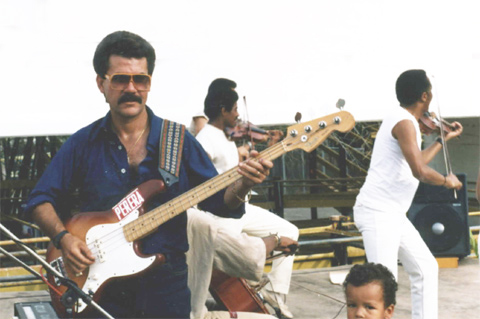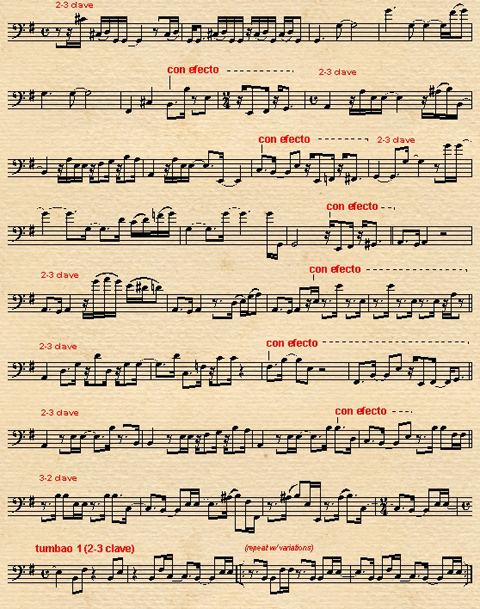Indice - Table of contents
Lo Nuevo[hide]
Grupos: Ritmo Oriental : 1988 - Vol. IX - 30 a...
Musicos: Rafael Paseiro Monzón
Musicos: Dennis Nicles Cobas
Musicos: Jiovanni Cofiño Sánchez
Musicos: Yasser Morejón Pino
Fotos: Tom Ehrlich : 2024 Monterey Jazz, P...
Resenas: Vacilón Santiaguero (Circle 9 ...
Staff: Bill Tilford
Fotos: Tom Ehrlich : 2024 Monterey Jazz, P...
Fotos: Tom Ehrlich : 2024 Monterey Jazz Fe...
Fotos: Tom Ehrlich : testing 123
Grupos: Pupy y los que S... : Discography - 1995- F...
Reportes: From The St... : Cubadisco 2...
Reportes: From The St... : Jazz Plaza ...
Fotos Del Día [hide]
The Music of Ritmo Oriental - Oye como suena mi bajo
"Oye como suena mi bajo, qué rico"

1977 Ritmo Oriental - Qué rico bailo yo (Rolando Vergara)
bass: Humberto Perera - arranger: Humberto Perera
source: Ritmo Oriental is Calling You
The central rhythmic motif of Qué rico bailo yo is the tresillo rhythm (0xx0 xx0x) which is used throughout the arrangement in every imaginable way:
xx0x 0xxx 0xx0 xxx0 2-3 rumba clave
xxxx xxxx 0xx0 xx0x on the 3-side
xxxx xxx0 xxx0 xx0x on the 3-side with the first note anticipated
xxxx xxxx 0xx0 xx0x on the 3-side "con efecto"
0xx0 xx0x xxxx xxxx on the 2-side "con efecto"
Look at the underlined notes to see how each of the main tumbaos handles the tresillo motif. The anticipation in tumbao 1 makes a huge difference in the way the groove feels.
xx0x 0xxx 0xx0 xxx0 2-3 rumba clave
xxxx xxxx xxxx xx00 (bass pickups)
xxx0 0x00 xx00 xx00
xxx0 0x00 xxx0 xx00 tumbao 1 - MIDI
xx0x 0xxx 0xx0 xxx0 2-3 rumba clave
xxxx xxxx xxxx xx00 (bass pickups)
xxx0 0x00 xx00 xx00
xxx0 0xxx 0xx0 xx00 tumbao 2 - MIDI
The montuno section features a very unusual approach to the coros and guías. Before vocalist Juan Crespo Maza enters, we hear coro 1 for 8 claves, a shortened version for 4 claves, a flute solo, and then a completely different coro 2. This whole section uses tumbao 1. When Maza finally comes in, his lead vocal section lasts a full 8 claves and uses tumbao 2. Each of his extended guías is a classic. He rides the offbeats like a rumbero, touching down on the clave accents at just the right places. I find myself at an uncharacteristic loss of words to describe his singing here and explain why I love it so much, but fortunately, I don't have to ... just listen! Being able to say "just listen" is why I've given up writing printed books - internet music-writing is an idea whose time has come.
Humberto Perera's arrangement and bass performance also fall into the "must-hear-to-believe" category.
Qué rico bailo yo - cuerpo
audio
MIDI (slow - no con efecto)

(bass transcription edited by Rob Holland)
This arrangement twists the clave in every imaginable way. Let's start with the last two lines of the transcription above (MIDI version). First of all, forget about the clave and just listen to Juan Crespo's unthinkably funky vocal part! Okay ... now that you've got your adrenaline pumping, this is what I call a "New York clave change" -- not because it was developed in New York, but because most New York musicians are violently opposed to any other method of changing clave direction. The next to last line starts in 3-2, and the bar of 2/4 allows tumbao 1 to start in 2-3 without interrupted the flow of the clave. Try clapping clave along with this slow-motion MIDI version.
If you were expecting the next example to demonstrate a "clave license" clave change, guess again! Remember, this is la Ritmo. There's plenty of "clave license" but no clave change! This audio excerpt (MIDI version) starts at the beginning of the second line of the transcription above. Again we encounter a bar of 2/4. but this time it disrupts the flow of the clave instead of preserving it! The clave direction is 2-3 before and after the odd bar! So instead creating an quirky asymmetrical break to avoid breaking the clave, la Ritmo breaks the clave to allow a quirky asymmetrical break! The quirky break is an artistic end unto itself rather than a means to an end.
To show that this "como sea" approach to clave runs throughout the history of Cuban music, let's take a quick peak into the future -- Los Van Van's Agua (2004). This exquisite 4-clave bass tumbao, in 3-2 clave, is used for the intro, parts of the cuerpo, and coro 1:
2004 Los Van Van - Agua (Samuell Formell)
bass: Pavel Molina - arranger: Samuell Formell
source: Chapeando
0xx0 xxx0 xx0x 0xxx 3-2 rumba clave
xxxx xxxx xxxx 0xx0 (bass pickups)
xxx0 0x0x 0xxx 0xx0
xxx0 0x0x 0xx0 0xx0
xxx0 0x0x xxxx 0xx0
xxx0 x0x0 x0x0 0xx0 tumbao 1 - MIDINow listen to the bloque-laden transition from the cuerpo to coro 1. Since the cuerpo and coro 1 are both in 3-2, there's no need for a bar of 2/4 and an asymmetrical bloque to flip the clave around, but this brilliant, edge-of-your-seat asymmetrical bloque is its own raison d être, so, just like the second line of Qué rico bailo yo, the arranger uses clave license without using a clave change.
0xx0 xxx0 xx0x 0xxx 3-2 rumba clave
x0xx 0xx0 xxxx xxxx
x0xx 0xx0 xxxx xxx0
xxxx xx0x xxxx x0x0
xxx0 x0x0 x0xx xxxx
xxxx 0xx0 - - - - - - - - - - (extra measure of 2/4)
xxx0 0x0x 0xxx 0xx0 tumbao 1 resumes in 3-2 clave
xxx0 0x0x 0xx0 0xx0
xxx0 0x0x xxxx 0xx0
xxx0 x0x0 x0x0 0xx0 bloques - MIDI





















